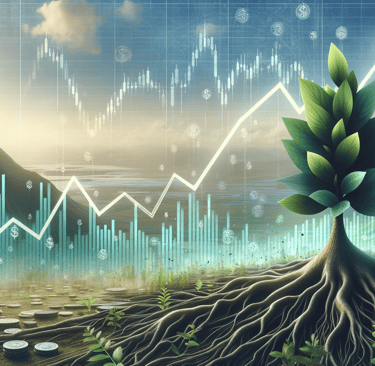What is Growth Investing?
Growth investing is a strategy that seeks to capitalize on the potential of companies that are expected to grow at an above-average rate compared to their peers or the market. This approach is characterized by a focus on companies with strong potential for revenue and earnings growth, innovative business models, and market leadership. Historically, growth investing emerged as a distinct strategy in the mid-20th century and has since adapted to the changing dynamics of global economies, evolving market trends, and technological advancements.
INVESTMENTSTOCK INVESTMENT
12/27/20233 min read


Understanding the Fundamentals
At its core, growth investing is about identifying companies that are poised for rapid expansion. Unlike value investing, which looks for undervalued stocks that the market may have overlooked, growth investing seeks out companies that are already demonstrating strong performance, with the expectation that they will continue to outperform. These companies often reinvest their earnings back into the business rather than paying dividends, fueling further growth.
Identifying Growth Stocks
Identifying potential growth stocks involves analyzing various market trends and company-specific metrics. Key indicators include a consistent record of revenue and earnings growth, high return on equity, and robust market share. Investors also look for companies with competitive advantages, innovative products or services, and strong management teams.
Strategies for Growth Investing
Effective growth investing strategies involve a long-term outlook, focusing on holding investments for several years to benefit from compounding growth. Diversification across different sectors and industries is also crucial to mitigate risks associated with market volatility and sector-specific downturns.
Risks and Rewards
Investing in growth stocks comes with its own set of challenges. These stocks often have higher price-to-earnings ratios, suggesting that investors are paying a premium for future growth expectations. This can make them more susceptible to market corrections. However, the reward potential is significant, as growth stocks can offer substantial returns if the companies realize their growth potential.
Growth Investing in Different Economic Conditions
The performance of growth stocks can vary greatly depending on the economic climate. In bullish markets, growth stocks typically perform well as investors are willing to pay a premium for growth. However, in bearish markets or economic downturns, these stocks can be more volatile and susceptible to larger declines.
The Role of Technology in Growth Investing
The technology sector has been a significant driver of growth investing in recent years. Tech companies, with their potential for innovation and disruption, often lead market growth. Investors in growth stocks frequently target tech companies that show promise in emerging technologies or have a strong foothold in their respective markets.
Global Growth Investing
Looking beyond domestic markets, global growth investing opens doors to emerging markets and international diversification. Countries with rapidly developing economies can offer unique growth opportunities, though they also come with additional risks such as political instability and currency fluctuations.
Growth Investing for Beginners
For beginners, growth investing can be both exciting and daunting. Starting with small investments in familiar sectors or companies can be a prudent approach. Utilizing resources like investment books, online courses, and financial news can help beginners build a solid foundation of knowledge.
Expert Perspectives
Learning from successful growth investors and studying case studies can provide insights into effective strategies and common pitfalls. Many renowned investors have made their fortunes through growth investing, and their experiences can serve as valuable lessons for new investors.
Tax Implications and Efficient Investing
Growth investing can have different tax implications than other strategies, particularly regarding capital gains taxes on profits from selling stocks. Understanding these implications and planning accordingly can help investors maximize their after-tax returns.
Future of Growth Investing
The future of growth investing may see an increased focus on sustainable and socially responsible investments. As global challenges like climate change and social inequality become more pressing, companies that offer solutions to these issues may become prime targets for growth investors.
Comparing Growth Investing Platforms
The rise of online brokers and investment apps has made growth investing more accessible than ever. Each platform offers different features, such as commission-free trades, research tools, and educational resources, which can influence an investor's decision-making process.
Personal Stories of Growth Investing
Personal success stories can be both inspiring and educational. They often highlight the importance of research, patience, and resilience in the face of market volatility.
Conclusion
Determining whether growth investing aligns with your investment goals and risk tolerance is crucial. It requires a balance of patience, risk management, and a willingness to stay informed about market trends and company developments.
FAQs
What makes a company a good candidate for growth investing?
A good candidate for growth investing typically has a strong competitive advantage, innovative products or services, and a solid track record of revenue and earnings growth.
How do economic cycles affect growth investing?
Economic cycles can significantly impact growth stocks. They tend to perform well during economic expansions but can be more volatile during recessions or market downturns.
What role does risk tolerance play in growth investing?
Risk tolerance is a critical factor in growth investing. Investors need to be comfortable with the higher volatility and potential for significant fluctuations in stock prices.
Can growth investing be part of a diversified portfolio?
Yes, growth investing can be a part of a diversified portfolio. It can be balanced with other investment strategies to manage overall risk.
How important is market timing in growth investing?
While timing can be important, growth investing typically focuses on long-term potential rather than short-term market movements. Consistent investment and patience are key.
